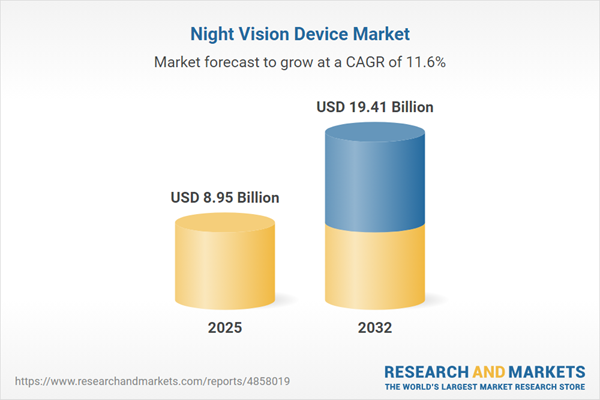Speak directly to the analyst to clarify any post sales queries you may have.
Night vision devices are transforming operational effectiveness across defense, security, and civilian enterprises by enabling users to detect and classify threats or objects in challenging visibility conditions. Senior decision-makers face heightened complexity as innovation, shifting international dynamics, and evolving user requirements redefine both risks and opportunities in this market.
Market Snapshot: Night Vision Device Market Size and Growth
The night vision device market grew from USD 8.06 billion in 2024 to USD 8.95 billion in 2025. It is forecasted to expand at a compound annual growth rate (CAGR) of 11.59%, reaching USD 19.41 billion by 2032.
Scope & Segmentation
- Product Types: Binoculars, Monoculars, Night Vision Goggles, Night Vision Sights, Scopes
- Platforms: Handheld, Helmet Mounted, Vehicle Mounted (including Aircraft, Land Vehicles, Marine), Weapon Mounted
- Generations: Gen I, Gen II, Gen III, Gen IV
- Wavelengths: Longwave Infrared, Midwave Infrared, Near Infrared, Shortwave Infrared
- Technologies: Active Illumination (Laser, LED), Image Intensifier (Green Phosphor, White Phosphor), Thermal Imaging (Cooled, Uncooled)
- Applications: Automotive, Law Enforcement, Military & Defense, Search & Rescue, Wildlife Observation
- Distribution Channels: Offline, Online (Brand Websites, eCommerce Platforms)
- Regions: Americas (United States, Canada, Mexico, Brazil, Argentina, Chile, Colombia, Peru), Europe, Middle East & Africa (United Kingdom, Germany, France, Russia, Italy, Spain, Netherlands, Sweden, Poland, Switzerland, United Arab Emirates, Saudi Arabia, Qatar, Turkey, Israel, South Africa, Nigeria, Egypt, Kenya), Asia-Pacific (China, India, Japan, Australia, South Korea, Indonesia, Thailand, Malaysia, Singapore, Taiwan)
- Key Companies: Includes American Outdoor Brands, American Technology Network, BAE Systems, Bharat Electronics, Elbit Systems, General Starlight Company, L3Harris Technologies, Raytheon, Tata Advanced Systems, Teledyne Technologies, Thales Group, and more.
Key Takeaways for Decision-Makers
- Rapid technological advancements, such as AI-driven analytics and multispectral imaging, are enhancing detection and accuracy while reducing operator workload.
- Growing geopolitical instability and asymmetric threats are accelerating modernization and system upgrade initiatives among defense and security agencies globally.
- Cross-sector adoption is expanding, with increasing demand from automotive safety, search and rescue, and wildlife monitoring, reflecting diversification beyond traditional defense uses.
- Design innovation is shifting toward modularity and open architectures, empowering users to integrate devices seamlessly with evolving digital platforms and sensors.
- Sustainability trends are influencing manufacturers to prioritize recyclable components and energy-optimized designs, aligning with regulatory and corporate social responsibility goals.
- Collaborative ecosystems—spanning manufacturers, research institutions, and system integrators—are shortening innovation cycles and expediting time to deployment.
Tariff Impact and Competitive Dynamics
- The introduction of United States tariffs in 2025 has reconfigured global supply chains and prompted OEMs to actively diversify suppliers and consider onshoring or nearshoring strategies.
- This environment is encouraging competitors in regions less affected by tariffs to capture market share, motivating U.S. suppliers to enhance value through bundled services.
- Companies are responding by redesigning devices to limit use of tariff-impacted components, exploring alternative sensor technologies, and leveraging additive manufacturing.
- Ongoing engagement between industry and policymakers is shaping efforts to develop tariff relief mechanisms linked to critical defense production.
Methodology & Data Sources
This analysis combines extensive secondary research with structured primary interviews involving industry experts, procurement officials, and operators. Quantitative models use triangulated market data from financial disclosures, trade databases, and patent analytics. Peer review and cross-validation ensure reliable, actionable results for senior stakeholders.
Why This Report Matters
- Identifies strategic levers for differentiation across product development, supply chain, and technology integration in the night vision device sector.
- Equips leaders to navigate export controls, tariff impacts, and regulatory changes, building resilience against evolving trade and geopolitical landscapes.
- Empowers decision-makers to prioritize investments and partnerships aligned to emerging user needs in both core and adjacent markets.
Conclusion
This report provides a comprehensive view of the evolving night vision device market, with actionable intelligence for leadership teams to optimize strategy, mitigate risk, and seize emerging opportunities. Insight-driven guidance supports effective decision-making in a rapidly reshaping landscape.
Additional Product Information:
- Purchase of this report includes 1 year online access with quarterly updates.
- This report can be updated on request. Please contact our Customer Experience team using the Ask a Question widget on our website.
Table of Contents
3. Executive Summary
4. Market Overview
7. Cumulative Impact of Artificial Intelligence 2025
Companies Mentioned
The companies profiled in this Night Vision Device market report include:- American Outdoor Brands, Inc.
- American Technology Network, Corp.
- B.E. Meyers & Co., Inc.
- BAE Systems PLC
- Bharat Electronics Limited
- Elbit Systems Ltd.
- General Starlight Company Inc.
- Global Tele Communications
- Janos Technology, LLC
- Kapri Corp.
- L3Harris Technologies, Inc.
- MKU LIMITED
- Newcon Optik
- Raytheon Technologies Corporation
- Rolta India Limited
- SATIR
- Schmidt & Bender GmbH & Co. KG
- Seek Thermal, Inc.
- Steele Industries Inc.
- Tata Advanced Systems Limited
- Teledyne Technologies
- Thales Group
- Yukon Advanced Optics Worldwide
- Rongland Ltd.
- AGM Global Vision, LLC
- Night Vision Devices, Inc.
- IRay Technology Co., Ltd.
- Hangzhou View Sheen Technology Co., Ltd.
- Fenn Night Vision Limited
Table Information
| Report Attribute | Details |
|---|---|
| No. of Pages | 181 |
| Published | November 2025 |
| Forecast Period | 2025 - 2032 |
| Estimated Market Value ( USD | $ 8.95 Billion |
| Forecasted Market Value ( USD | $ 19.41 Billion |
| Compound Annual Growth Rate | 11.5% |
| Regions Covered | Global |
| No. of Companies Mentioned | 30 |









